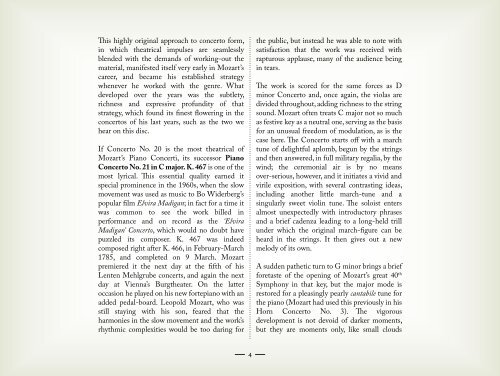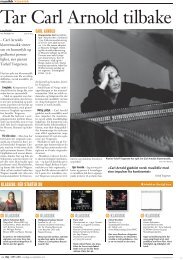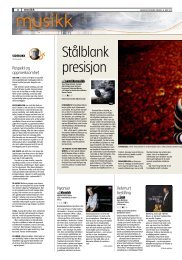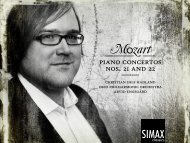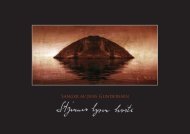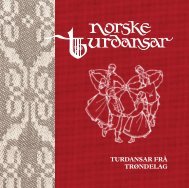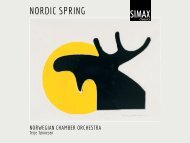4-6 Piano Concerto No. 22 in E at Major, K. 482 - Grappa Musikkforlag
4-6 Piano Concerto No. 22 in E at Major, K. 482 - Grappa Musikkforlag
4-6 Piano Concerto No. 22 in E at Major, K. 482 - Grappa Musikkforlag
You also want an ePaper? Increase the reach of your titles
YUMPU automatically turns print PDFs into web optimized ePapers that Google loves.
This highly orig<strong>in</strong>al approach to concerto form,<br />
<strong>in</strong> which the<strong>at</strong>rical impulses are seamlessly<br />
blended with the demands of work<strong>in</strong>g-out the<br />
m<strong>at</strong>erial, manifested itself very early <strong>in</strong> Mozart’s<br />
career, and became his established str<strong>at</strong>egy<br />
whenever he worked with the genre. Wh<strong>at</strong><br />
developed over the years was the subtlety,<br />
richness and expressive profundity of th<strong>at</strong><br />
str<strong>at</strong>egy, which found its f<strong>in</strong>est flower<strong>in</strong>g <strong>in</strong> the<br />
concertos of his last years, such as the two we<br />
hear on this disc.<br />
If <strong>Concerto</strong> <strong>No</strong>. 20 is the most the<strong>at</strong>rical of<br />
Mozart’s <strong>Piano</strong> Concerti, its successor <strong>Piano</strong><br />
<strong>Concerto</strong> <strong>No</strong>. 21 <strong>in</strong> C major. K. 467 is one of the<br />
most lyrical. This essential quality earned it<br />
special prom<strong>in</strong>ence <strong>in</strong> the 1960s, when the slow<br />
movement was used as music to Bo Widerberg’s<br />
popular film Elvira Madigan; <strong>in</strong> fact for a time it<br />
was common to see the work billed <strong>in</strong><br />
performance and on record as the ‘Elvira<br />
Madigan’ <strong>Concerto</strong>, which would no doubt have<br />
puzzled its composer. K. 467 was <strong>in</strong>deed<br />
composed right after K. 466, <strong>in</strong> February-March<br />
1785, and completed on 9 March. Mozart<br />
premiered it the next day <strong>at</strong> the fifth of his<br />
Lenten Mehlgrube concerts, and aga<strong>in</strong> the next<br />
day <strong>at</strong> Vienna’s Burgthe<strong>at</strong>er. On the l<strong>at</strong>ter<br />
occasion he played on his new fortepiano with an<br />
added pedal-board. Leopold Mozart, who was<br />
still stay<strong>in</strong>g with his son, feared th<strong>at</strong> the<br />
harmonies <strong>in</strong> the slow movement and the work’s<br />
rhythmic complexities would be too dar<strong>in</strong>g for<br />
the public, but <strong>in</strong>stead he was able to note with<br />
s<strong>at</strong>isfaction th<strong>at</strong> the work was received with<br />
rapturous applause, many of the audience be<strong>in</strong>g<br />
<strong>in</strong> tears.<br />
The work is scored for the same forces as D<br />
m<strong>in</strong>or <strong>Concerto</strong> and, once aga<strong>in</strong>, the violas are<br />
divided throughout, add<strong>in</strong>g richness to the str<strong>in</strong>g<br />
sound. Mozart often tre<strong>at</strong>s C major not so much<br />
as festive key as a neutral one, serv<strong>in</strong>g as the basis<br />
for an unusual freedom of modul<strong>at</strong>ion, as is the<br />
case here. The <strong>Concerto</strong> starts off with a march<br />
tune of delightful aplomb, begun by the str<strong>in</strong>gs<br />
and then answered, <strong>in</strong> full military regalia, by the<br />
w<strong>in</strong>d; the ceremonial air is by no means<br />
over-serious, however, and it <strong>in</strong>iti<strong>at</strong>es a vivid and<br />
virile exposition, with several contrast<strong>in</strong>g ideas,<br />
<strong>in</strong>clud<strong>in</strong>g another little march-tune and a<br />
s<strong>in</strong>gularly sweet viol<strong>in</strong> tune. The soloist enters<br />
almost unexpectedly with <strong>in</strong>troductory phrases<br />
and a brief cadenza lead<strong>in</strong>g to a long-held trill<br />
under which the orig<strong>in</strong>al march-figure can be<br />
heard <strong>in</strong> the str<strong>in</strong>gs. It then gives out a new<br />
melody of its own.<br />
A sudden p<strong>at</strong>hetic turn to G m<strong>in</strong>or br<strong>in</strong>gs a brief<br />
foretaste of the open<strong>in</strong>g of Mozart’s gre<strong>at</strong> 40 th<br />
Symphony <strong>in</strong> th<strong>at</strong> key, but the major mode is<br />
restored for a pleas<strong>in</strong>gly pearly cantabile tune for<br />
the piano (Mozart had used this previously <strong>in</strong> his<br />
Horn <strong>Concerto</strong> <strong>No</strong>. 3). The vigorous<br />
development is not devoid of darker moments,<br />
but they are moments only, like small clouds<br />
pass<strong>in</strong>g acr<br />
itself not w<br />
subsidiary m<br />
melancholy<br />
by three<br />
recapitul<strong>at</strong>io<br />
splendour b<br />
The exquisi<br />
of the conce<br />
It has some<br />
of the open<br />
muted first<br />
triplets <strong>in</strong><br />
subtle, shift<br />
the piano en<br />
the throbbi<br />
cross-rhyth<br />
contribute<br />
the music, w<br />
cav<strong>at</strong><strong>in</strong>a. M<br />
central sect<br />
rest<strong>at</strong>ed it<br />
Though thi<br />
hackneyed<br />
utterance o<br />
imag<strong>in</strong><strong>at</strong>ive<br />
The ma<strong>in</strong> th<br />
various chr<br />
<strong>in</strong> the other<br />
fragment o<br />
but breezy<br />
4


